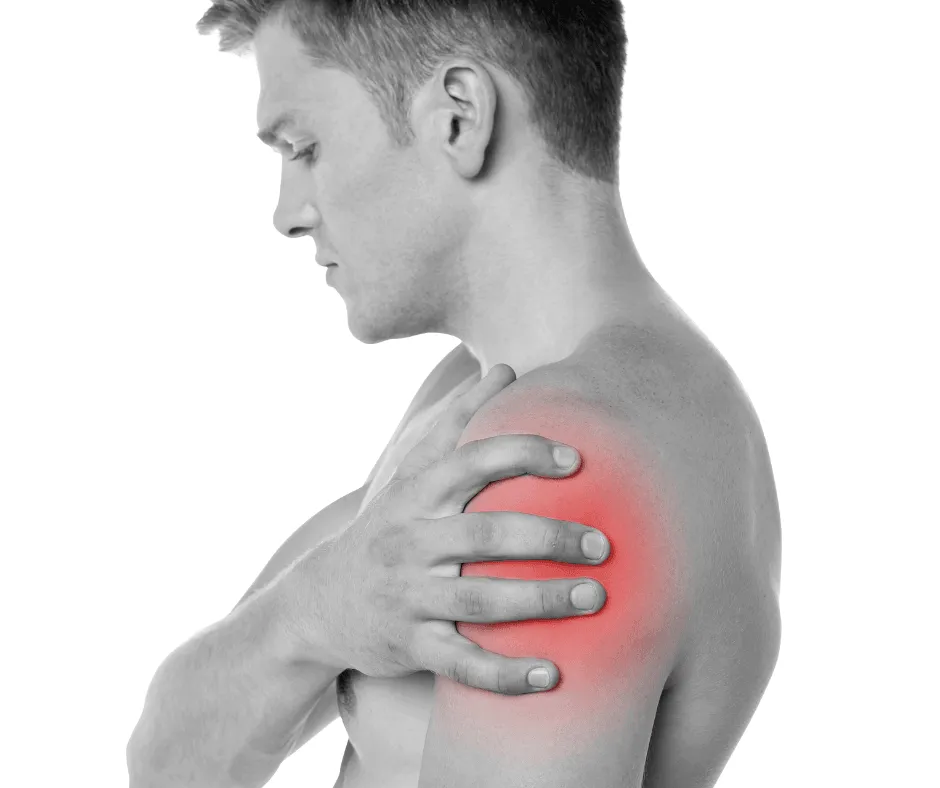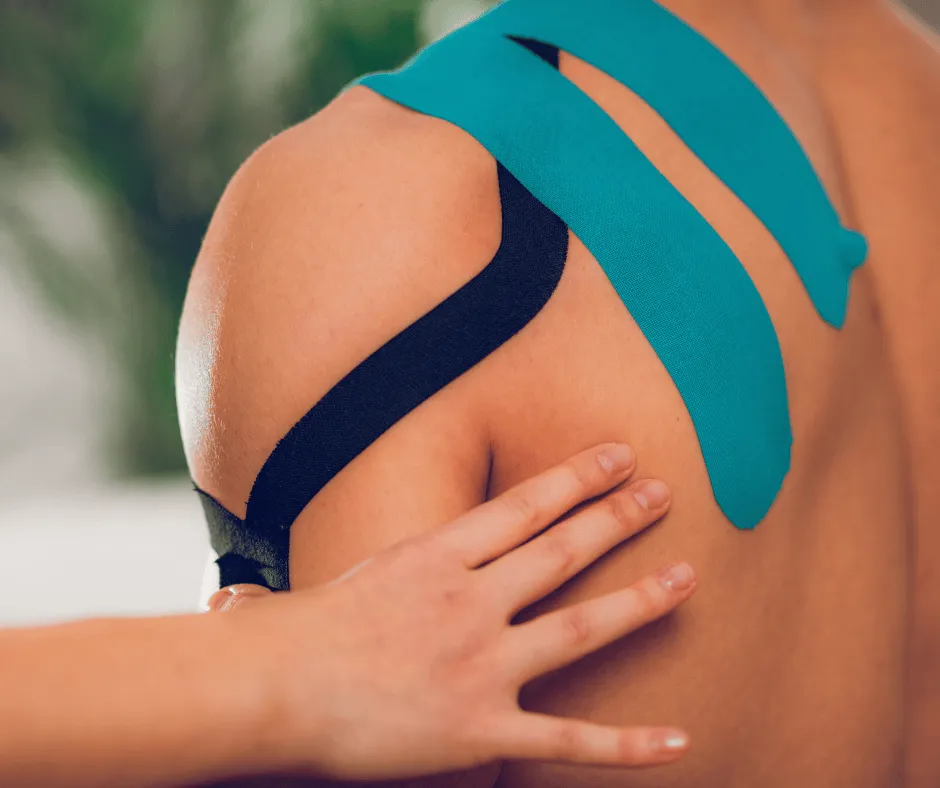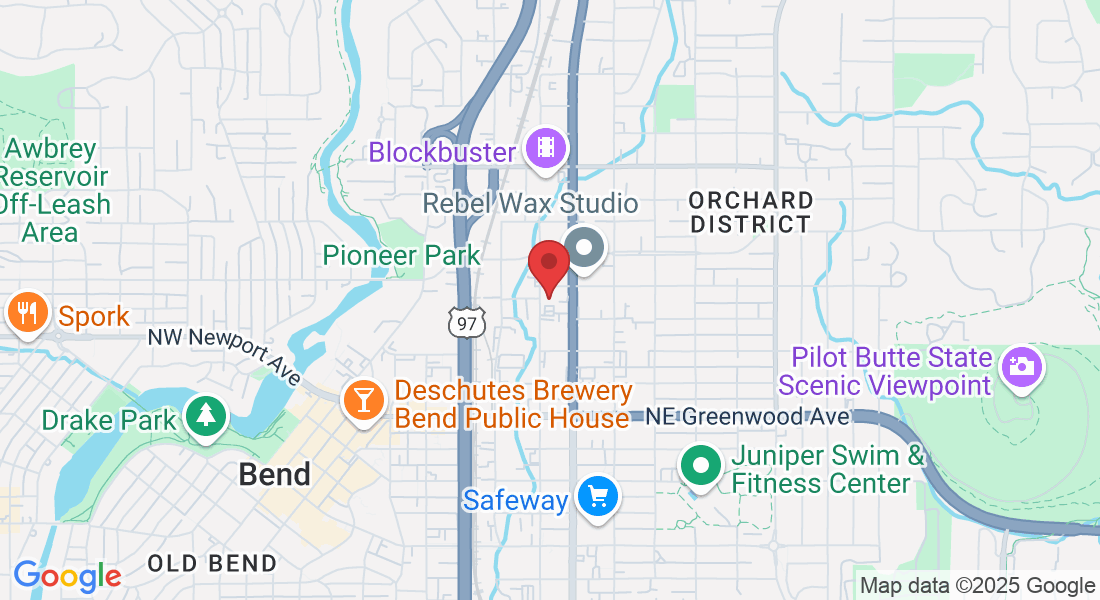Shoulder Pain Relief
Rediscover Life Without Shoulder Pain
Renowned as a marvel of human anatomy, the shoulder joint offers unparalleled mobility and flexibility, enabling us to perform a myriad of tasks, from reaching out for a book on the top shelf to throwing the perfect spiral with a football. Yet, this exceptional range of motion comes at a price. Over time, instability or impingement of the soft tissues or bony structures in your shoulder may cause discomfort and pain. This pain might be transient or persisting, may manifest only when you move, or may be a constant presence, prompting the need for professional intervention.
We're pleased to share that minor shoulder pain frequently shows a promising response to strategies such as physical therapy, the use of shoulder supports, upholding a healthy lifestyle, all of which can bring about substantial relief. Here at PhysioFit, we comprehend that each person's journey to a pain-free life is distinct. We're dedicated to delivering personalized, science-backed treatments with a fitness-centric approach to effectively ease your shoulder discomfort, helping you return to your everyday activities.
What You Should Know
The human body's most versatile joint, the shoulder, owes its expansive motion range to a quartet of muscles and their corresponding tendons, collectively known as the rotator cuff.
Intriguingly, shoulder pain may sometimes be a symptom of an issue originating from another part of the body, such as the neck or lungs. This phenomenon, known as referred pain, typically presents as a persistent ache that doesn't worsen with shoulder movement.
Shoulder discomfort or pain can result from inflammation, injury, or bone alterations surrounding the rotator cuff.
A proper diagnosis of a shoulder problem involves a thorough evaluation from a professional

Understanding the Common Causes of Shoulder Pain
The shoulder is a complex joint, and it's susceptible to a variety of injuries and conditions. Here are some of the most common causes of shoulder pain:
Dislocation: This happens when the top of your arm is pulled back excessively or rotated too far, causing it to pop out of its socket. Symptoms include pain, weakness, swelling, numbness, and bruising in the shoulder.
Separation: This injury affects the acromioclavicular (AC) joint, where the collarbone and shoulder blade meet. A hard blow or fall can tear the ligaments, leading to a visible bump on top of your shoulder due to a displaced collarbone.
Fracture: A fall or severe blow can result in a broken or cracked bone. The clavicle (collarbone) and humerus (upper arm bone) are most prone to fractures, leading to intense pain, bruising, and restricted movement.
Cartilage Tear: Repeated motion, a fall, or a significant force can damage the cartilage that cushions your shoulder joint. Symptoms include pain during overhead reach, shoulder weakness, and a sensation of catching, locking, or grinding.
Rotator Cuff Tear: The group of muscles and tendons comprising your rotator cuff secure your arm in place and enable overhead lifting. Overuse, falls, or natural aging can cause damage, leading to pain (particularly at night), reduced lifting ability, and a crackling sound during movement.
Frozen Shoulder: Characterized by restricted joint movement, this condition is caused by the build-up of abnormal tissue bands (adhesions) within the joint, often following pain or surgery-induced disuse.
Impingement: This occurs when the tendons of the rotator cuff are pinched between the shoulder bones, causing pain and swelling, particularly in individuals who frequently lift their arms overhead.
Bursitis: Overuse, repetitive motions, or an injury can inflame the bursa (a fluid-filled sac that cushions the joint), leading to pain, especially during shoulder movement.
Apart from these, other potential causes of shoulder pain include: Osteoarthritis, Rheumatoid arthritis, Heart attack, Bone Spurs, Referred pain, and Tendinitis.
Remember, if you resonate with any of the symptoms or conditions mentioned, we highly recommend making an appointment with us for a thorough evaluation and personalized treatment plan.
Preventive Measures for Shoulder Pain
The bright side of shoulder issues is that they can often be resolved without resorting to surgery. However, prevention is always better than cure, and here are some ways you can safeguard your shoulders.
Heed Your Body's Signals: Do not dismiss shoulder discomfort that follows any activity. If the pain is intense and persistent, consult your doctor. Remember, enduring unnecessary pain might only exacerbate the situation.
Maintain Overall Health: Stay in prime physical condition with regular exercise and a balanced diet. It's not just a ticket to overall wellness, but it also helps in warding off potential injuries.
Adopt Correct Exercise Habits: Ensure a proper warm-up before your workouts. Gradually ease into a sport or activity if you've been inactive for a while. Learn and adhere to the correct techniques of weight lifting, and avoid lifting beyond your capacity.
Stay Safe at Work: Be conscious of your shoulder health in your work environment -
Prioritize good posture, whether you're sitting or standing.
Follow safe lifting practices. Maintain a straight back and leverage your leg strength.
Every hour, take a few minutes to move around and stretch.
If your job involves a desk, ensure your workstation is ergonomically set up for comfortable computer use.
Avoid Overreaching: When you need to access high places, use a step stool. Arrange frequently used items within easy reach, in lower drawers or shelves.
Remember, caring for your shoulder health can keep you active and pain-free in the long run.

Common Symptoms of Shoulder Pain
Heat or a reddened appearance in your shoulder
Restricted arm mobility
Stiffness and reduced strength in your muscles
A sensation of clicking, popping, or grinding during arm movements
Discomfort in your neck, arm, or back
Remember, if you resonate with any of the symptoms or conditions mentioned, we highly recommend making an appointment with us for a thorough evaluation and personalized treatment plan.
Please Note: The information provided on our website is intended for general education and is not a substitute for professional medical advice. Each individual's situation and body is different. Therefore, what may work for one person may not work for another. We care about your well-being and advise you to reach out to us to discuss your specific needs before implementing any advice from our website.
Your Source for All Things Physical Therapy in Bend Oregon
The PhysioBlog

How Physical Therapy at PhysioFIT Can Improve Your Golf Swing
Please Note: The information provided on our website is intended for general education and is not a substitute for professional medical advice. Each individual's situation and body are different. Therefore, what may work for one person may not work for another. We care about your well-being and advise you to reach out to us to discuss your specific needs before implementing any advice from our website. If you’d like to explore this more or would like to schedule a time with a physical therapist in Bend Oregon, contact us at PhysioFITBend.com
Key Takeaways:
Physical therapy can address common golf swing issues: Through specialized exercises and treatments, physical therapy can help golfers improve their swing mechanics, correct imbalances, and optimize their technique to enhance performance on the golf course.
Physical therapy can prevent and treat common golf injuries: Golfers often experience injuries such as rotator cuff strains, golfer's elbow, and lower back pain. Physical therapy can provide targeted interventions to prevent these injuries and help golfers recover faster, allowing them to enjoy the game without pain or limitation.
Increasing range of motion is key for a better golf swing: Physical therapists can design personalized exercise programs to improve flexibility, mobility, and range of motion in golfers. This increased range of motion can lead to a smoother and more powerful golf swing, resulting in greater distance and accuracy.
How Physical Therapy Can Improve Your Golf Swing
Physical therapy has been proven to enhance the efficiency and effectiveness of a golfer's swing. By addressing specific physical limitations and imbalances, physiotherapy at PhysioFIT can optimize your golf swing technique. With a focus on injury prevention and performance enhancement, this specialized treatment improves mobility, stability, and strength, allowing golfers to achieve greater accuracy and distance in their shots.
Furthermore, our expert PT’s at PhysioFIT provide personalized exercises and stretches based on an individual's specific needs, thereby optimizing their golf swing mechanics and reducing the risk of future injuries. By incorporating physical therapy into their routine, golfers can experience significant improvements in their game, enhancing their overall performance on the golf course.
Common Golf Swing Issues
Here are some of the most common golf swing issues:
Incorrect Grip: Inconsistent shots, lack of control, and reduced accuracy.
Poor Posture: Limited rotation, loss of power, and the inability to maintain balance.
Lack of Flexibility: Restricted range of motion, difficulty generating clubhead speed, and increased risk of injury.
Improper Weight Shift: Inconsistent ball striking, loss of power, and difficulty maintaining a consistent tempo.
Over the Top Swing: Out-to-in swing path, slices, and poor trajectory.
Early Release of the Hands: Inconsistent strikes, lack of power, and difficulty controlling the ball flight.
In addition to these common golf swing issues, other important aspects to consider include the importance of proper alignment, tempo, and timing. Addressing these issues can enhance overall performance and improve the golf swing.
To overcome these challenges, it is recommended to:
Seek professional guidance: A skilled physical therapist can analyze your swing mechanics, identify specific areas of improvement, and develop a tailored program just for you.
Focus on strengthening and flexibility exercises: Targeting key muscle groups used in the golf swing can enhance stability, power, and overall performance.
Practice mindful training: By incorporating mental and visual imagery techniques into your training, you can improve concentration, focus, and rhythm.
Utilize video analysis: Capturing your swing on video can provide valuable feedback, allowing you to identify and correct any issues more effectively.
Maintain an active warm-up routine: Engaging in stretches and warm-up exercises before playing can help prevent injuries and improve overall swing performance.
Take regular lessons: Working with a golf coach to refine your swing technique and address any recurring issues can lead to long-term improvement.
By addressing common golf swing issues and implementing these suggested strategies, golfers can improve their swing mechanics, enhance performance, and achieve more consistent and accurate shots.
Most Common Golf Injuries
In the world of golf, injuries are an unfortunate reality for many players. While the sport may appear gentle and relaxed, the repetitive motions and intense swings can lead to a wide range of physical ailments. Here are the top five most common golf injuries:
1. Back Pain: The torque and rotation of the golf swing can put immense pressure on the lower back, leading to strains, sprains, and even herniated discs.
2. Golfer's Elbow: Also known as medial epicondylitis, this injury occurs when the tendons on the inner side of the elbow become inflamed or damaged due to repetitive swinging motions.
3. Rotator Cuff Strain: The rotational forces involved in a golf swing can cause strain or tears in the muscles and tendons of the shoulder, resulting in limited mobility and pain.
4. Knee Injuries: The pivoting and weight transfer during a swing can lead to knee injuries, including meniscus tears, ligament strains, and tendonitis.
5. Wrist Injuries: The repetitive impact of hitting the ball can strain the tendons and ligaments in the wrist, leading to conditions such as golfer's wrist or wrist tendonitis.
While these injuries are the most common, it's important to note that each person's experience with golf-related injuries may vary. Consulting with one of our physical therapists at PhysioFIT, can provide individualized treatment and guidance to address your specific needs.
Golf injuries can easily hinder performance and enjoyment of the sport. By understanding the most common challenges faced on the course and seeking professional guidance, golfers can take proactive steps to prevent and treat these injuries, ultimately achieving optimal physical health and performance.
How Physical Therapy Can Help Golfers
Physical therapy plays a crucial role in optimizing golfers' abilities. By leveraging tailored exercises and techniques, it helps enhance their swing mechanics, improve flexibility, and prevent injuries. Through its targeted approach, physical therapy ensures that golfers can maintain proper body alignment and develop the necessary core strength and balance to execute powerful and accurate swings. Additionally, it aids in rehabilitating any existing injuries and expediting the recovery process. With the integration of physical therapy, golfers can unlock their full potential and elevate their overall performance on the golf course.
Increasing Range of Motion to Improve Golf Swing
Flexibility plays a crucial role in optimizing your golf swing. By increasing your range of motion, you can improve your swing technique, increase clubhead speed, and achieve better overall performance on the golf course. Here's a step-by-step guide to help you enhance your flexibility and ultimately improve your golf swing:
Stretching Exercises: Begin by incorporating stretching exercises into your pre-golf routine. Focus on targeting the main muscle groups involved in your swing, such as the shoulders, hips, and back. Perform dynamic stretches that mimic the movements of your swing to warm up and prepare your muscles.
Mobility Drills: Engage in mobility drills that aim to increase the range of motion in specific joints used during the golf swing, like the shoulders and hips. These drills can include exercises such as arm circles, hip rotations, and thoracic spine mobility exercises.
Yoga or Pilates: Consider integrating yoga or Pilates into your fitness routine. These activities focus on improving flexibility, core strength, and balance, all of which are essential for an efficient and powerful golf swing. Practicing yoga or Pilates regularly can help lengthen and strengthen your muscles, leading to increased range of motion.
Resistance Training: Incorporate resistance training exercises to not only strengthen your muscles but also enhance flexibility. Include exercises that target both the major muscle groups and the smaller stabilizing muscles, as these muscles contribute to your overall range of motion during the golf swing.
Seek Professional Help: Consider consulting with one of our physical therapists at PhysioFIT or a golf fitness specialist who can design a customized exercise program tailored to your specific needs. They can assess your current range of motion and provide specific exercises to address any limitations or restrictions you may have.
In addition to these steps, it is vital to listen to your body and avoid overexertion or pushing beyond your limits. Consistency is key when it comes to improving flexibility, so aim to incorporate these exercises into your regular fitness routine. By increasing your range of motion through targeted exercises, you can enhance your golf swing and ultimately improve your performance on the course.
Conclusion
Physical therapy at PhysioFIT is a game-changer for improving your golf swing. By addressing specific physical issues and imbalances, our therapists can help you achieve a more efficient and powerful swing. Through personalized exercises and techniques, we can enhance your flexibility, strength, and coordination, resulting in a better overall golf performance.
Our experts understand the biomechanics of the golf swing and will tailor your therapy sessions to target areas that need improvement, such as core stability, hip rotation, and shoulder mobility. With our specialized approach, you can take your golf swing to the next level and see significant improvements in your game.
In addition to addressing physical limitations, our physical therapy sessions also focus on injury prevention. By identifying and correcting any imbalances or weaknesses in your body, we can help reduce the risk of common golf-related injuries, such as golfer's elbow or lower back pain. Our therapists will provide you with exercises and stretches that target the specific muscles involved in the golf swing, ensuring that you can enjoy the game without the fear of injuries holding you back.
At PhysioFIT, we have a track record of success in improving golfers' performance. Our approach combines evidence-based practices with individualized attention, allowing us to unlock your full potential on the golf course. Don't let physical limitations hinder your game; invest in physical therapy at PhysioFIT and see the difference it can make in your golf swing.
FAQ
How can physical therapy at PhysioFIT improve your golf swing?
Physical therapy at PhysioFIT can improve your golf swing by addressing common swing issues such as poor balance, posture, and limited joint motion. It can also help reduce pain, improve agility, increase power for longer drives, and enhance strength and mobility. By working with a physical therapist, you can receive a personalized treatment plan to maximize your body's energy transfer during the swing and improve overall efficiency and speed.
What are the most common golf injuries that physical therapy can treat?
Physical therapy can effectively treat common golf injuries such as hunching and rotational stress, shoulder pain, rotator cuff issues, Tennis Elbow (inflammation of the elbow's inner tendon), and knee pain caused by stabilizing and hip rotation during the swing. Through targeted exercises and treatment methods, physical therapy can help alleviate pain, promote healing, and prevent re-injury.
Which exercises can I do to improve my golf swing and avoid injury?
There are several exercises you can incorporate into your routine to improve your golf swing and prevent injury. These exercises include planks to strengthen your core, standing wood chops to enhance torque and flexibility, dumbbell raises/rotator cuff exercises to strengthen shoulder muscles, and lateral lunges to improve hip range of motion. These exercises target key muscle groups involved in the golf swing and can be done without any equipment.
How can physical therapy increase range of motion to improve my golf swing?
Physical therapy can address limitations in mid-back and hip mobility, which are crucial for a proper golf swing. By incorporating specific exercises into your treatment plan, physical therapy can help improve your range of motion in these areas. Improved mobility allows for a smoother and more efficient swing, enhancing your overall performance on the golf course.
Please Note: It's important to note that any exercises or techniques that are shared should be performed under the guidance of a qualified bend physical therapy expert to ensure correct technique and to prevent injuries. A physical therapist can provide a customized exercise program based on the individual's fitness level, goals, and any existing injuries or conditions. If you’d like to explore this more or would like to schedule a time with a physical therapist in Bend Oregon, contact us at PhysioFITBend.com
Copyright PhysioFIT 2025 . All rights reserved


